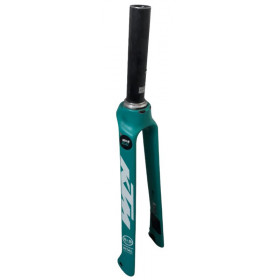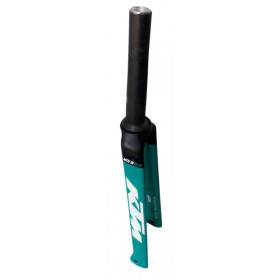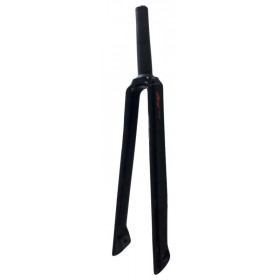-
 New product UsedKTM F11 carbon fork disc
New product UsedKTM F11 carbon fork disc- €79.99
-
 UsedKTM revelator Alto F12 carbon fork disc used
UsedKTM revelator Alto F12 carbon fork disc used- €80.99
-
 UsedKTM F12 nano carbon fork disc used
UsedKTM F12 nano carbon fork disc used- €59.99
Showing 1-3 of 3 item(s)
Road bike disc fork: features and specifications
The road bike disc fork has become essential for cyclists seeking performance, precision, and safety. Positioned at the front of the frame, the fork holds the front wheel, influences the stiffness of the cockpit, and plays a crucial role in the overall handling of the road bike. With the rise of disc brakes, fork designs have evolved to meet new mechanical constraints and deliver an optimal riding experience.
A design tailored for disc braking
Unlike forks designed for rim brakes, the road bike disc fork must withstand the lateral forces generated during braking. Manufacturers typically reinforce the left side of the fork (where the caliper is mounted) to ensure rigidity and prevent any torsion.
Dropouts now adopt the thru-axle standard (most commonly 12 mm), which provides better wheel alignment and increased reliability compared to traditional quick-release systems.
Materials and weight: balancing stiffness and comfort
Most disc road forks are made from carbon fiber, a material prized for its light weight and vibration-damping properties. More affordable models may use aluminum, which is durable and budget-friendly, though slightly less comfortable.
On average, a carbon disc road fork weighs between 350 and 450 grams, depending on the model and the amount of reinforcement needed to accommodate the brake caliper.
Compatibility and dimensions
When choosing a fork, several key factors should be considered:
-
Steerer tube: most modern forks use a tapered steerer (1"1/8 – 1"1/2), ensuring stiffness and stable handling.
-
Tire clearance: newer forks allow wider clearance, making it possible to fit 28 mm or even 32 mm tires for greater comfort and versatility.
-
Mounting standard: the most common option is Flat Mount, offering a sleek integration and aerodynamic advantage.
The importance of design and aerodynamics
Beyond technical performance, the road disc fork is also engineered with aerodynamics and style in mind. Slim profiles reduce drag, and some models feature fully integrated internal routing for the brake hoses, giving the bike a clean, modern look.
Conclusion
The road bike disc fork is a key component for both performance and comfort. Its specific design allows riders to make the most of disc braking power while ensuring steering precision and reliability. Whether you prioritize lightness, aerodynamics, or durability, choosing the right fork is essential to optimizing your road bike and enjoying every ride to the fullest.